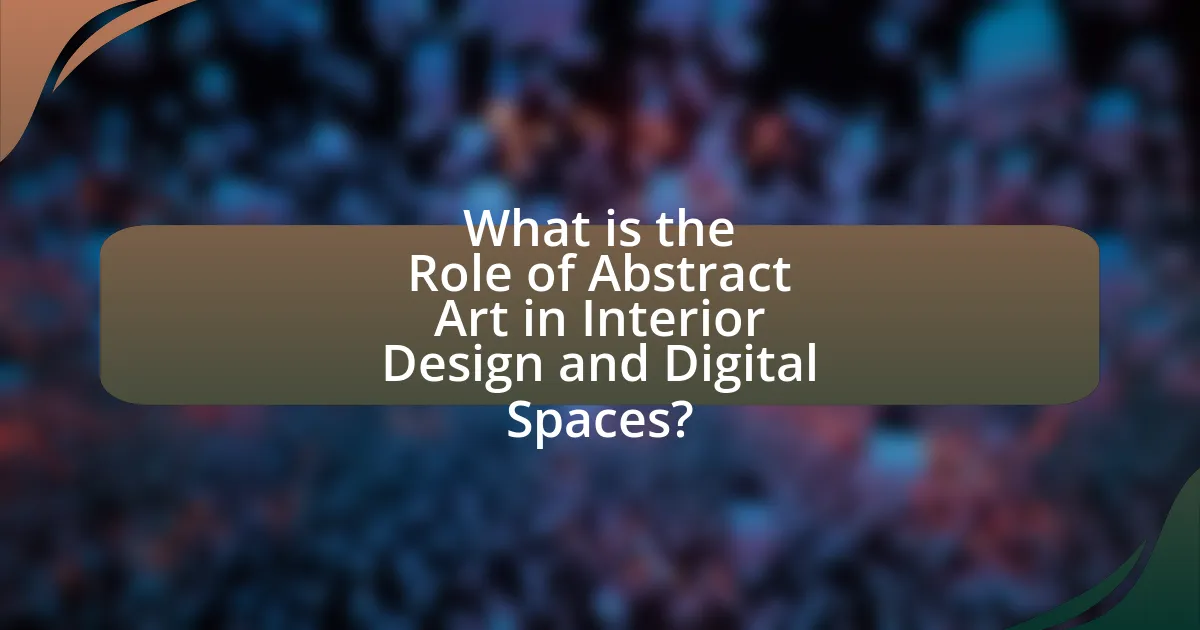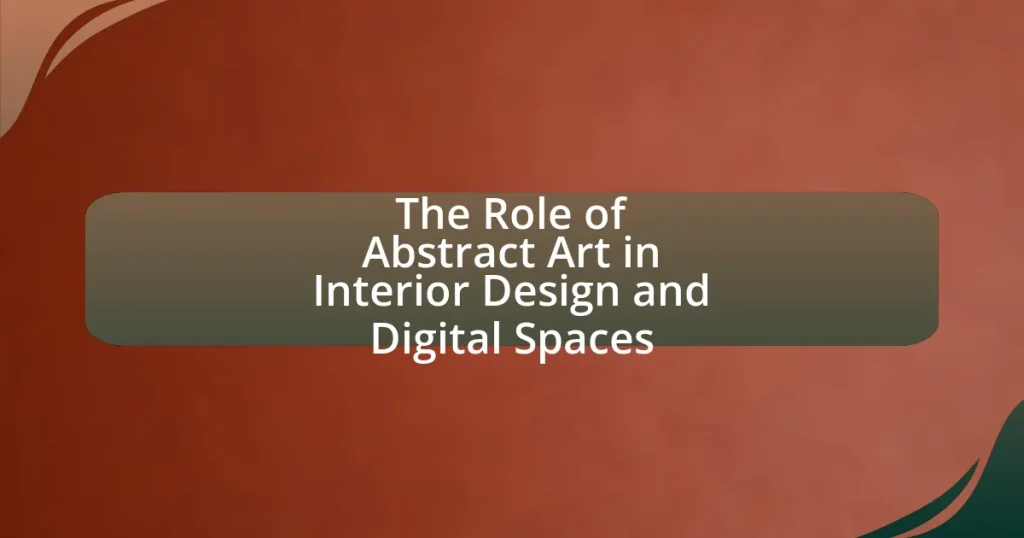Abstract art plays a crucial role in both interior design and digital spaces by enhancing aesthetic appeal and fostering emotional responses. It serves as a focal point in interiors, stimulating conversation and transforming atmospheres, while also contributing to branding and user engagement in digital environments. Key elements such as color, form, and texture in abstract art influence mood and spatial perception, making spaces more vibrant and engaging. The article explores the historical context of abstract art, its evolution in design, emerging trends, and practical tips for incorporating it effectively into various environments. Additionally, it highlights the significance of abstract art in bridging physical and digital realms, enhancing user experience, and influencing emotional responses.

What is the Role of Abstract Art in Interior Design and Digital Spaces?
Abstract art plays a significant role in interior design and digital spaces by enhancing aesthetic appeal and fostering emotional responses. In interior design, abstract art serves as a focal point, creating visual interest and stimulating conversation, which can transform a space’s atmosphere. For instance, studies show that environments featuring abstract art can increase creativity and reduce stress, making them more conducive to productivity and relaxation. In digital spaces, abstract art contributes to branding and user engagement by providing unique visual elements that capture attention and convey brand identity. The use of abstract designs in websites and applications can lead to improved user experience, as they often evoke curiosity and encourage exploration.
How does abstract art influence the aesthetics of interior design?
Abstract art significantly influences the aesthetics of interior design by introducing unique visual elements that enhance spatial perception and emotional resonance. The use of bold colors, dynamic shapes, and non-representational forms in abstract art can create focal points within a room, guiding the viewer’s eye and establishing a mood. For instance, a study published in the Journal of Environmental Psychology indicates that artwork can affect emotional responses and perceptions of space, suggesting that abstract pieces can make environments feel more vibrant and engaging. This interplay between abstract art and interior design not only elevates the overall aesthetic but also contributes to the psychological well-being of occupants by fostering creativity and inspiration.
What elements of abstract art enhance visual appeal in spaces?
Color, form, and texture are key elements of abstract art that enhance visual appeal in spaces. Color creates emotional responses and can influence the mood of a room; for instance, vibrant colors can energize a space, while softer hues can promote calmness. Form, through shapes and lines, adds structure and can guide the viewer’s eye, creating a sense of movement and flow within the environment. Texture introduces depth and tactile interest, making the artwork more engaging and inviting. Collectively, these elements contribute to a dynamic visual experience, transforming spaces into stimulating environments that reflect personal style and creativity.
How does color theory in abstract art affect mood in interior environments?
Color theory in abstract art significantly influences mood in interior environments by utilizing color combinations to evoke specific emotional responses. For instance, warm colors like red and orange can create feelings of warmth and energy, while cool colors such as blue and green tend to promote calmness and relaxation. Research indicates that color can affect psychological states; a study published in the journal “Color Research and Application” found that colors can influence mood and behavior, with certain hues linked to increased productivity or tranquility. Therefore, the strategic application of color theory in abstract art can enhance the emotional atmosphere of a space, making it more conducive to the desired mood.
Why is abstract art significant in digital spaces?
Abstract art is significant in digital spaces because it fosters creativity and emotional engagement, allowing viewers to interpret and connect with the artwork on a personal level. In digital environments, abstract art can transcend traditional boundaries, enabling artists to explore new mediums and techniques that enhance visual experiences. For instance, the use of digital tools allows for dynamic compositions and interactive elements, which can captivate audiences and encourage deeper exploration of the art. Additionally, studies show that abstract art can stimulate cognitive processes, promoting innovative thinking and problem-solving skills, which are essential in today’s digital landscape.
What are the unique characteristics of abstract art in digital formats?
Abstract art in digital formats is characterized by its use of non-representational forms, vibrant colors, and dynamic compositions that leverage digital tools for creation and manipulation. Unlike traditional abstract art, digital abstract art can incorporate elements such as animation, interactivity, and multimedia integration, allowing for a more immersive experience. The digital medium enables artists to experiment with layers, textures, and effects that are not possible in physical formats, resulting in unique visual experiences. Additionally, the accessibility of digital platforms allows for broader distribution and engagement with audiences, enhancing the reach and impact of abstract art in contemporary design contexts.
How does abstract art contribute to user experience in digital design?
Abstract art enhances user experience in digital design by fostering emotional engagement and stimulating creativity. This form of art often evokes personal interpretations, allowing users to connect with the design on a deeper level. Research indicates that visual stimuli, such as abstract art, can increase user satisfaction and retention by creating a memorable and immersive environment. For instance, a study published in the Journal of Environmental Psychology found that aesthetically pleasing designs, including abstract elements, significantly improve users’ emotional responses and overall experience. Thus, integrating abstract art into digital design not only beautifies the interface but also enriches user interaction and satisfaction.
What are the historical contexts of abstract art in design?
Abstract art in design emerged in the early 20th century, influenced by movements such as Cubism, Futurism, and Dadaism. These movements challenged traditional representation and emphasized abstraction as a means of expression. The rise of abstract art coincided with significant historical events, including World War I and the Industrial Revolution, which prompted artists to explore new forms and materials. For instance, Wassily Kandinsky, a pioneer of abstract art, believed that colors and shapes could evoke emotions independent of the physical world, reflecting the tumultuous societal changes of his time. Additionally, the Bauhaus movement integrated abstract art into functional design, promoting the idea that art and design should serve everyday life. This historical context laid the foundation for the incorporation of abstract art into various design disciplines, including interior design and digital spaces, where it continues to influence aesthetics and user experiences today.
How has abstract art evolved in interior design over the decades?
Abstract art has evolved in interior design from the early 20th century’s focus on geometric shapes and bold colors to contemporary interpretations that emphasize minimalism and personal expression. In the 1920s and 1930s, movements like Bauhaus and De Stijl integrated abstract art into functional design, promoting simplicity and utility. By the 1960s and 1970s, abstract expressionism influenced interior spaces, with artists like Jackson Pollock inspiring designs that embraced spontaneity and emotional resonance. In recent decades, the rise of digital technology has allowed for innovative applications of abstract art in virtual environments, enabling designers to create immersive experiences that blend physical and digital realms. This evolution reflects broader cultural shifts, with abstract art increasingly serving as a means of personal storytelling and emotional connection within interior spaces.
What movements in art history have influenced contemporary abstract design?
Contemporary abstract design has been significantly influenced by movements such as Abstract Expressionism, Bauhaus, and Minimalism. Abstract Expressionism, which emerged in the mid-20th century, emphasized spontaneous, automatic, or subconscious creation, impacting the emotional and expressive aspects of contemporary design. The Bauhaus movement, founded in 1919, integrated art and technology, promoting functional design and simplicity, which continues to resonate in modern abstract aesthetics. Minimalism, characterized by simplicity and the reduction of form, has also shaped contemporary abstract design by encouraging the use of clean lines and a limited color palette. These movements collectively inform the principles and practices of contemporary abstract design, making them foundational to its evolution.
How does abstract art bridge the gap between physical and digital spaces?
Abstract art bridges the gap between physical and digital spaces by utilizing visual elements that transcend traditional representation, allowing for a seamless integration of both realms. This form of art often employs bold colors, shapes, and textures that can be easily translated into digital formats, making it adaptable for various applications such as virtual reality environments, digital installations, and online galleries. The fluidity of abstract art enables it to maintain its aesthetic impact regardless of the medium, as evidenced by the increasing use of augmented reality to display abstract pieces in physical spaces, enhancing viewer interaction and engagement.
What trends are emerging in the use of abstract art in modern design?
Emerging trends in the use of abstract art in modern design include the integration of bold colors and geometric shapes, which enhance visual interest and create dynamic spaces. Designers increasingly favor large-scale abstract pieces that serve as focal points in both residential and commercial interiors, reflecting a shift towards minimalism where fewer, impactful artworks replace cluttered decor. Additionally, the rise of digital platforms has led to the incorporation of abstract art in virtual environments, such as websites and social media, where it is used to convey brand identity and engage audiences. This trend is supported by data indicating that visually striking content increases user engagement by up to 94%, highlighting the effectiveness of abstract art in modern design contexts.
What practical tips can be applied when incorporating abstract art into design?
Incorporating abstract art into design can be effectively achieved by selecting pieces that complement the existing color palette and style of the space. This approach ensures that the artwork enhances the overall aesthetic rather than clashes with it. For instance, using abstract art with colors that echo the room’s hues can create a cohesive look, while contrasting colors can add visual interest. Additionally, considering the scale of the artwork is crucial; larger pieces can serve as focal points in spacious areas, while smaller works can be grouped to create a gallery wall effect. Research indicates that art can influence mood and perception, making thoughtful integration of abstract art beneficial for enhancing the ambiance of both interior and digital environments.
How can one select the right abstract art pieces for different spaces?
To select the right abstract art pieces for different spaces, one should consider the color scheme, size, and mood of the area. Matching the artwork’s colors with the existing palette enhances visual harmony; for instance, a vibrant piece can energize a neutral room. The size of the artwork should be proportionate to the space; larger pieces work well in expansive areas, while smaller works suit intimate settings. Additionally, the mood of the space should guide the selection; calming pieces with soft colors are ideal for relaxation areas, while bold, dynamic works can invigorate social spaces. Research indicates that art can significantly influence emotional responses, making thoughtful selection crucial for achieving desired atmospheres.
What are common mistakes to avoid when using abstract art in design?
Common mistakes to avoid when using abstract art in design include neglecting the overall theme of the space, which can lead to visual dissonance. Designers often fail to consider the scale of the artwork in relation to the surrounding elements, resulting in either overwhelming or underwhelming effects. Additionally, using too many competing colors or styles can create chaos rather than harmony, detracting from the intended aesthetic. Lastly, overlooking the emotional impact of abstract art can lead to a disconnect between the artwork and the viewer, undermining the design’s purpose.
